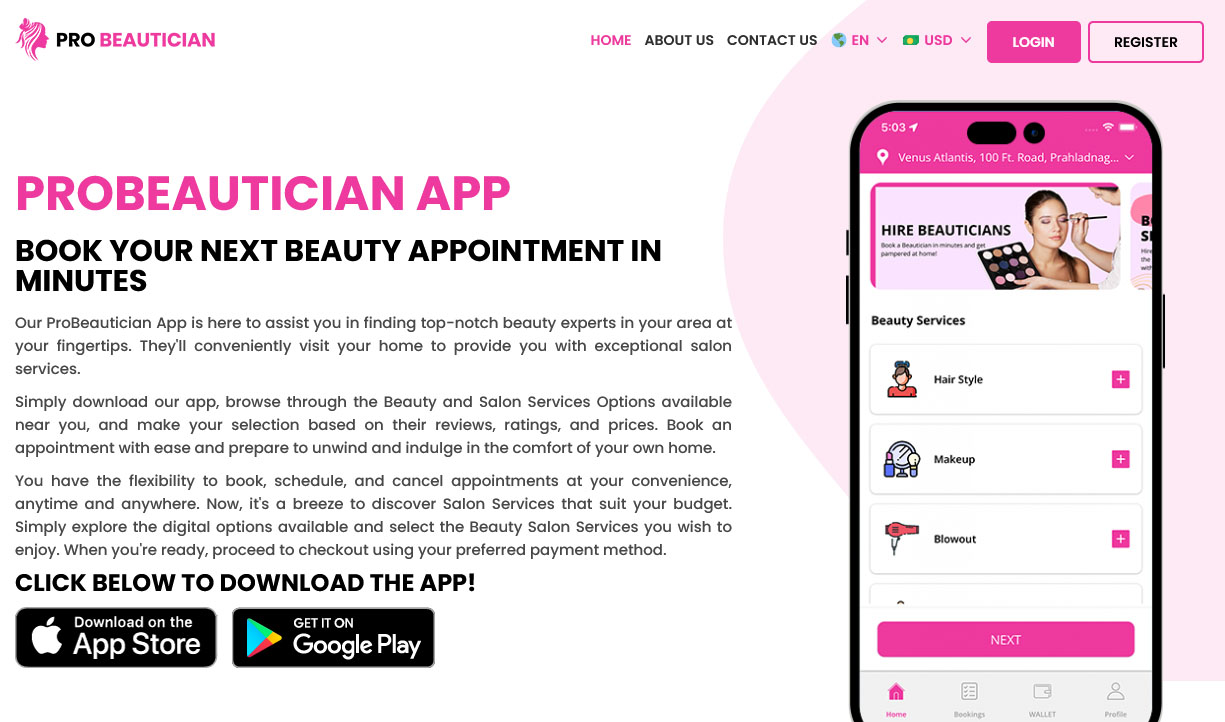
If you have a budget in place, you will be better able to understand the costs related to the app development process. This helps you organise the actions required to create a valuable on-demand application.
Knowing that the ideal app development firm is on your side will allow you to unwind. If done properly, it may attract millions of people to your app and increase your revenue by converting them into potential users.
To offer your salon business a clear direction, you should be aware that you need to develop an on-demand beauty salon app rather than a standard mobile app.
Let’s look into the costs associated with creating the on-demand beauty salon app, how it is done, what factors affect it, and how to minimise costs.
What’s Included in the Budget for Salon App Development?
Setting up a reasonable budget is essential for the development of your app. So, in order to help you comprehend in everyday language, we’ve identified the elements that go into creating a successful mobile app.
The following are the customs:
App Creation
The actual effort required to make your app functional is shown here. It include creating the minimal viable product (MVP), introducing innovative new features, and taking care of all the technical work in the background.
Responsive App Design:
How your app looks and feels is super important for its success. You got to decide on colours, fonts, layout, and more to create a user-friendly design that people will love.
Operating System Decisions
You got to choose whether your app will be for iOS, Android, or both. This decision can affect your budget big time.
Content Writing
Before diving into the building phase, you got to have all the words ready. That means writing all the text for your app, like instructions and explanations, so users can easily figure it out.
Project Management
To make things run smoothly, you need someone to keep everything in check. A project manager handles all the time and resources needed to get your app from start to finish. They’ll keep you updated on the progress and milestones.
App Maintenance Costs
Once the app is built, you can’t just forget about it. Quality assurance and testing make sure your app works flawlessly. Once it’s good to go, you’ll see the return on your investment.
App Marketing
You made a cool On-demand Beauty Salon App, but how will people know about it? That’s where app marketing comes in. It’s all about promoting your app to the right audience and showing them how awesome it is. Don’t skip this step just because the development is done – it’s crucial for success.
Factors Influencing The App Development Cost
Vendor type and location
The price of developing an app is influenced by things like the service provider’s location and type. Small businesses that employ freelancers, specialised businesses, and major agencies make up the three main categories of vendors. Small businesses could be more affordable, but they might not have the skills for challenging jobs. Specialist businesses may cost more but deliver superior results. Large agencies charge more but have experienced staff.
The price depends on the kind of service you require. Consider end-to-end development if you have a clear idea and want a team to create the software from the ground up. Dedicated development teams can be helpful if you desire more freedom and have ambiguous requirements.
The pricing estimate for developing a mobile app heavily depends on the vendor’s location. when compared to Asian countries, the average developer rate in the US and Europe. Therefore, it is advised that you pick an Indian app development company to save a significant amount of money.
Complexity and the number of app features
The number of features an app has affects its price, but the complexity of those features has a greater impact. Simple features like login and subscription take some time, and advanced features like payment system integration and visual analytics cost more money and need more work.
The cost of development may increase as a result of integrating APIs, and if you want to include cutting-edge technologies like machine learning and artificial intelligence, your budget will be further strained. Even services that appear standard, like geolocation, have significant expenses.
Before dedicating significant resources to a feature, it’s critical to evaluate its feasibility and necessity in order to maintain control over your app development budget.
Complexity of UX/UI design
In today’s software development landscape, user satisfaction is the key focus. With countless applications available, customers have the luxury of selecting solutions that offer clear design, easy navigation, and top-notch performance. That’s why setting aside a reasonable budget for design is crucial when estimating app development costs.
Costs associated with developing a custom app include UI/UX design, which includes buttons, icons, typefaces, logos, and other crucial components. Although hiring UI/UX designers can be expensive, doing so can guarantee that your app has a beautiful visual aesthetic and a great user experience. In the cutthroat app industry, prioritising design quality is a wise step to draw in and keep consumers.
Development approach
Wondering about the app development costs for iOS and Android? Well, you’ve got some options! You can go for separate native app development for each platform, which usually gives a top-notch user experience but comes with a higher price tag. Or, you can save some bucks and build a cross-platform solution that runs on both iOS and Android.
On average, app development costs can range from $35,000 to $60,000, regardless of the platform. But here’s the deal: Native development for Android and iPhone tends to be pricier because you need two separate source codebases for each. However, it lets developer’s access cool built-in functions like GPS and the camera, making it easier to create more complex apps.
On the other hand, cross-platform development is a bit more budget-friendly, but you might need some extra libraries or coding to implement certain functions. So, if you’re after a fancy app with loads of features, go native. But if you need something more basic, a hybrid solution should do the trick. It all depends on what you’re looking to achieve!
Ongoing maintenance and support
The app development process doesn’t stop after the launch. To keep your app up-to-date and relevant, continuous monitoring and maintenance are essential. If you neglect regular updates, bug fixing, and adding new features, your app may become outdated, leading customers to seek newer and more innovative options available in the market.
On average, you should allocate up to 15% of your total app development budget for ongoing maintenance to ensure your app stays in top shape and keeps your users engaged.
How The Right App Development Company Will Help You Build App on Budget?
Curbing app development costs requires a combination of strategic planning, resource optimization, and efficient execution.
Here are some specific steps the team can assist you in taking to reduce On-demand Salon App Development expenditure:
Clearly Defined Scope
Create a brief and clear scope for your app as a starting point. Focus on key features that support the main goal of the app rather than adding unnecessary features. To avoid duplication of effort, make sure the development team is made fully aware of the requirements.
Open Source and Third-Party Tools: Leverage open-source libraries, frameworks, and third-party APIs to speed up development and reduce costs. Much popular functionality, such as payment processing and authentication, can be integrated using existing tools rather than building them from scratch.
Cross-Platform Development: Consider using cross-platform development frameworks like React Native or Flutter. These technologies allow you to write code once and deploy it on multiple platforms, reducing development time and cost compared to building separate native apps for iOS and Android.
Minimum Viable Product (MVP): Start with an MVP version of the app that includes only the most critical features. This allows you to launch the app quickly, gather user feedback, and make informed decisions about further development, thereby avoiding unnecessary expenses on features that may not be essential.
Agile Development Methodology: Adopt Agile practices for development, which involve iterative and incremental progress. This approach allows for continuous feedback, early detection of issues, and timely adjustments, minimizing the risk of costly rework.
Outsourcing: Consider outsourcing certain aspects of app development to specialized external teams or freelancers. Outsourcing can be cost-effective, especially for non-core functionalities, but ensure you work with reputable and experienced partners.
In-House Talent Development: Invest in upskilling your in-house development team to reduce reliance on expensive external resources and improve development efficiency.
Continuous Testing: Implement a robust testing strategy throughout the development process. Early detection and resolution of issues help prevent costly bug fixes and rework later on.
Post-Launch Monitoring: Monitor app performance and user behaviour post-launch to identify areas of improvement and prioritize future development efforts effectively.
Flexible App Architecture: Design a scalable and flexible app architecture that allows for future updates and enhancements without major restructuring.
Negotiate with Development Partners: If you work with third-party development teams, negotiate the project cost and explore the possibility of performance-based payment plans.
By applying these cost-saving strategies, you can effectively curb app development costs while still delivering a high-quality product that meets user expectations. Remember that cutting costs should not compromise the overall user experience or app functionality.
White-Label App Development Benefits – Budget-Friendly App Solutions
- Faster Time-to-Market: White-label app development companies offer pre-built solutions, reducing development time and getting your app to market faster.
- Cost-Effective Solution: Building from scratch can be expensive. White-label companies offer affordable options, saving you money on development costs.
- Proven Track Record: White-label companies have experience in developing successful apps, increasing the chances of your app’s success.
- Customizable: Despite being pre-built, white-label apps can be customized to suit your brand and specific requirements.
- Reliable Support: White-label companies usually provide ongoing support and updates, ensuring your app remain functional and up-to-date.
- Focus on Core Competencies: Outsourcing app development allows you to focus on your business’s core activities while leaving the technical aspects to experts.
- Reduced Risks: Utilizing a pre-built solution lowers the risk of technical glitches and development delays.
- Scalability: White-label apps can easily accommodate growth and handle increased user demand.
- Streamlined Process: White-label companies already have established processes, making the app development journey smoother.
- Competitive Advantage: By launching faster and at a lower cost, you can gain a competitive edge in the market.
Final Thoughts
It takes careful consideration to select the best mobile app development business that won’t blow your app development budget. Factors like their experience, expertise, development approach, communication, technical proficiency, project management, pricing, and contract terms all come into play. By adhering to these guidelines, you can discover a trustworthy and skilled app development partner who will assist you in creating a successful On-demand Beauty App and smoothly launching it in record time.







